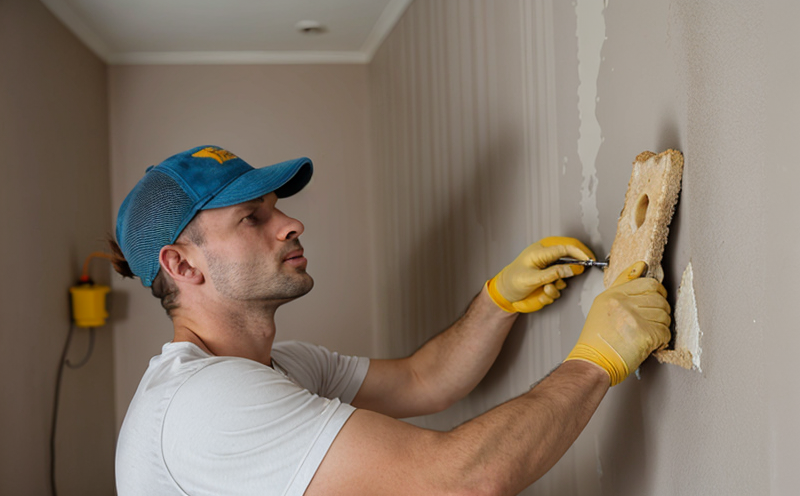Wall plastering inspection
The process of wall plastering inspection is a critical aspect in ensuring the durability, safety, and aesthetic appeal of construction projects. Wall plastering involves applying layers of mortar to walls for various purposes such as providing a smooth surface, improving thermal insulation, enhancing moisture resistance, or simply adding an appealing finish.
During this inspection process, several parameters are evaluated to ensure compliance with relevant standards and specifications. The scope includes checking the thickness, density, uniformity, adhesion strength, and the overall quality of the plastering work. This ensures that the walls meet not only aesthetic requirements but also functional ones such as resistance to wear and tear.
Standard practices in wall plastering inspection often include visual inspections, tactile checks, and sometimes more advanced techniques like ultrasonic testing or laser scanning for accurate measurements. These methods help detect any imperfections early on which could lead to future issues if left unnoticed.
Compliance with industry standards such as ISO, ASTM, and others is essential for quality assurance. For instance, ISO 13790 provides guidelines on the thermal performance of buildings, while ASTM C625 gives specifications for lightweight aggregate concrete used in wall construction.
The primary goal of thorough inspection during wall plastering projects is to identify any deviations from established norms before they become costly problems later down the line. By adhering strictly to these processes and procedures, contractors can ensure that their work meets not only current regulations but also future-proof requirements.
Quality and Reliability Assurance
The quality and reliability of wall plastering inspections are paramount in the construction industry. Ensuring that walls meet specified standards is crucial for both short-term benefits like aesthetic appeal and long-term advantages such as durability and safety.
- Visual Inspection: This involves a thorough examination using the naked eye to check for visible defects, inconsistencies, or areas where additional work may be required.
- Tactile Check: Using hands to feel any irregularities in texture which might indicate poor application techniques or material quality issues.
- Instrumentation: Employing specialized equipment like laser scanners for precise measurements and ultrasonic testers to assess the thickness of plaster layers non-invasively.
The use of advanced technologies ensures that inspections are as accurate as possible, minimizing errors due to human perception alone. Additionally, regular calibration of instruments guarantees consistent results over time.
| Standard | Description |
|---|---|
| ISO 13790 | Guidelines on the thermal performance of buildings including walls. |
| ASTM C625 | Specifications for lightweight aggregate concrete used in wall construction. |
These standards provide a benchmark against which all inspections are conducted. Adherence to them helps maintain high levels of quality and reliability, thereby enhancing customer satisfaction and trust.
Competitive Advantage and Market Impact
Complying with wall plastering inspection standards not only ensures the structural integrity and aesthetic appeal of buildings but also provides significant competitive advantages in the marketplace. In an increasingly regulated environment, meeting these stringent requirements can set a company apart from its competitors by demonstrating commitment to excellence.
From a market perspective, adhering to industry best practices such as those outlined in ISO and ASTM standards signals to potential clients that your services are reliable and meet international standards. This can attract more business opportunities both domestically and internationally.
Moreover, consistent adherence to these protocols contributes positively towards reputation management. Clients who see repeatable successes from projects inspected according to established guidelines will likely choose you again for future endeavors.
Use Cases and Application Examples
- New Construction: Ensuring that new buildings comply with design specifications right from the beginning.
- Retrofitting: Checking existing structures for signs of wear and tear, then making necessary repairs to extend their lifespan.
- Maintenance: Periodic inspections throughout the building lifecycle to catch issues early and prevent costly repairs later on.
- Renovation: Ensuring that renovations align with original design intent without compromising safety or functionality.
In these scenarios, wall plastering inspection plays a vital role in maintaining high standards of construction quality. Whether it's a newly built residential complex or an old commercial building undergoing extensive renovation, rigorous inspection processes are indispensable steps towards achieving desired outcomes.
| Application Scenario | Description |
|---|---|
| New Construction | Ensuring compliance with initial design requirements and achieving the intended aesthetic look. |
| Retrofitting | Detecting areas of weakness or damage in older structures, addressing these before they become critical problems. |
| Maintenance | Implementing regular checks to monitor the condition of existing walls and address minor issues promptly. |
| Renovation | Safeguarding against deviations from original plans while ensuring safety and functionality are maintained throughout. |





